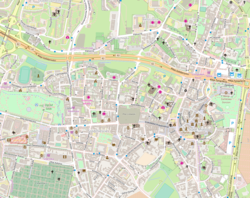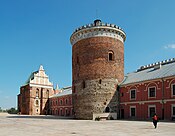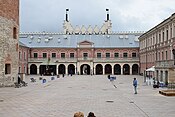
Lublin is the ninth-largest city in Poland and the second-largest city of historical Lesser Poland. It is the capital and the centre of Lublin Voivodeship with a population of 336,339. Lublin is the largest Polish city east of the Vistula River, located 153 km (95 mi) southeast of Warsaw.

Radom is a city in east-central Poland, located approximately 100 kilometres south of the capital, Warsaw. It is situated on the Mleczna River in the Masovian Voivodeship. Radom is the fifteenth-largest city in Poland and the second-largest in its province with a population of 196,918 (30.06.2023)

The Royal Castle in Warsaw is a state museum and a national historical monument, which formerly served as the official royal residence of several Polish monarchs. The personal offices of the king and the administrative offices of the royal court were located in the Castle from the 16th century until the final partition of Poland in 1795. Situated in the Castle Square, at the entrance to the Old Town, the Royal Castle holds a significant collection of Polish and European art.
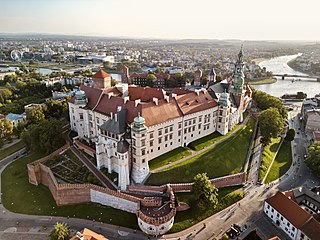
The Wawel Royal Castle and the Wawel Hill on which it sits constitute the most historically and culturally significant site in Poland. A fortified residency on the Vistula River in Kraków, it was established on the orders of King Casimir III the Great and enlarged over the centuries into a number of structures around an Italian-styled courtyard. It represents nearly all European architectural styles of the Medieval, Renaissance and Baroque periods.

The Gothic architecture arrived in Poland in the first half of the 13th century with the arrival of the Dominican and Franciscan orders. The first elements of the new style are evident in the foundation of the Dominican Trinity church in Kraków (1226–1250), built by Bishop Iwo Odrowąż. Rebuilding of the Wrocław Cathedral, started in 1244, was another early manifestation of the Gothic style. The earliest building in Poland built entirely in the Gothic style is the chapel of St. Hedwig in Trzebnica (1268–1269), on the grounds of a Cistercian monastery.

Biecz is a town and municipality in southeastern Poland, in Lesser Poland Voivodeship, Gorlice County. It is in the Carpathian Mountains, in the Doły Jasielsko-Sanockie, by the Ropa River. Due to its rich history, it is often referred to as "little Kraków" or the "pearl of the Carpathians". The many preserved medieval city walls and buildings have also given rise to the nickname "Polish Carcassonne" for both Biecz and the town of Szydłów.
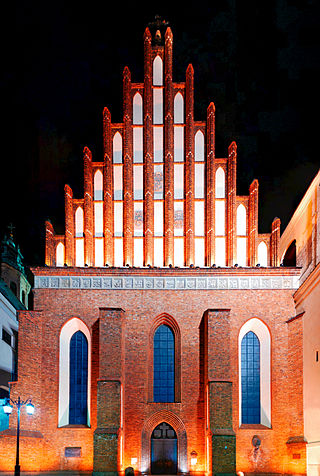
St John's Archcathedral is a Catholic church within the Old Town precinct in Warsaw, Poland. The Brick Gothic structure stands on Świętojańska Street, adjacent to the Jesuit Church. St John's is one of three major cathedrals in the city, but it is the only temple that also possesses the title of an archcathedral. It is the mother church of the Archdiocese of Warsaw and one of Poland's national pantheons. Along with the old city, the church has been listed by UNESCO as a World Heritage Site.

The Cathedral Basilica of St Stanislaus and St Ladislaus of Vilnius is the main Catholic cathedral in Lithuania. It is situated in Vilnius Old Town, just off Cathedral Square. Dedicated to the Christian saints Stanislaus and Ladislaus, the church is the heart of Catholic spiritual life in Lithuania.

The Royal Castle in Poznań dates from 1249 and the reign of Przemysł I. Located in the Polish city of Poznań, it was largely destroyed during the Second World War but has since been partly rebuilt.

The Ducal Castle, also known as the Pomeranian Dukes' Castle, and Szczecin Castle, is a renaissance castle in the city of Szczecin, Poland, located at the Castle Hill in the Stare Miasto neighbourhood, near the Oder river. It is built in the gothic and Pomeranian mannerism architectural style. The castle was the seat of the dukes of Pomerania-Stettin of the House of Pomerania, who ruled the Duchy of Pomerania from 1121 to 1637. The building history originates in 1346, when Duke Barnim III began the construction of the ducal housing complex, and continues to 1428, when, under the rule of Casimir V, it was expanded, forming the castle. Currently, it is one of the largest cultural centres in the West Pomeranian Voivodeship, Poland.

Chęciny is a town in Kielce County, Świętokrzyskie Voivodeship, southern Poland, with 4,361 inhabitants as of December 2021. It was first mentioned in historical documents from 1275, and obtained its city charter in 1325. At that time was one of major urban centers of northern Lesser Poland.

Wąwolnica is a village in Puławy County, Lublin Voivodeship, in eastern Poland. It is the seat of the gmina called Gmina Wąwolnica. It lies approximately 19 kilometres (12 mi) south-east of Puławy and 31 km (19 mi) west of the regional capital Lublin.

The Sandomierz Royal Castle is a medieval structure in Sandomierz, Poland. It was built on a slope of Vistula River by Casimir III the Great and extended in the 16th century. The original building was blown up in 1656, leaving only the west wing standing. It was later transformed into a Renaissance styled residence with the west wing preserved as a museum.
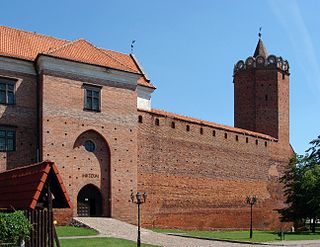
The Łęczyca Royal Castle is a medieval castle in Łęczyca, Poland, that was erected by Casimir III the Great as a fortification during 1357–1370.

Mannerist architecture and sculpture in Poland dominated between 1550 and 1650, when it was finally replaced with baroque. The style includes various mannerist traditions, which are closely related with ethnic and religious diversity of the country, as well as with its economic and political situation at that time. The mannerist complex of Kalwaria Zebrzydowska and mannerist City of Zamość are UNESCO World Heritage Sites.

Niepołomice Royal Castle is a Gothic castle from the mid-14th century, rebuilt in the late Renaissance style and called the second Wawel. It is situated in Niepołomice, Poland and was extensively reconstructed in the 1990s.

Radzyń Chełmiński Castle is a Brick Gothic monastery-castle completed in 1330 as the seat of the Teutonic Knights' Commandry. It lies near Castle Lake to the north of the town of Radzyń Chełmiński. Three of the four walls and most of the internal buildings of the keep are ruined.

The Lubomirski Palace in Opole Lubelskie, Lublin Voivodship, Poland, is a much-altered 18th-century palace formerly belonging to the Słupecki and Lubomirski families.
The following is a timeline of the history of the city of Lublin, Poland.

The Chapel of the Holy Trinity, also known as Lublin Castle Chapel, is a Gothic chapel with a Renaissance gable located within the courtyard of Lublin Castle in Lublin, Poland. The chapel adjoins the museum of the castle complex and is an integral part of the site. It is known for its fifteenth-century frescoes in the Byzantine or Orthodox style, unusual for Catholic Poland.

